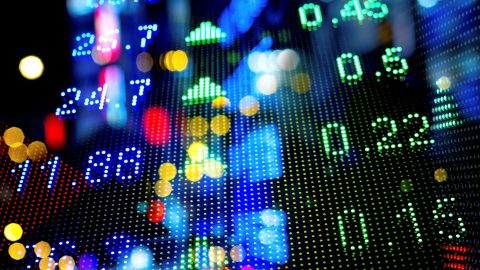Global equity markets kicked off the year on the right foot, extending gains of the new bull market which started almost exactly a year ago. However, the market setup has changed considerably over the last couple of months.
In 2020, the global economy slid into an unforeseen recession as governments tried to stop the coronavirus from spreading by imposing nationwide lockdowns and mobility restrictions. Accordingly, equity indices fell at a speed barely seen before, bringing to an end the longest bull market in history. However, thanks to the swift actions taken by major central banks and governments, investors quickly turned more positive. The flood of liquidity and fiscal support resulted in an increased demand for assets on financial markets, bidding up prices for stocks and bonds.
The S&P 500
Accommodative monetary policies all around the world drove global yields to historically low levels. In the US, 10 year yields hit an all-time low of 0.51% in August, and many eurozone countries are currently able to issue debt at negative yields. While low interest rates were helpful for equity indices especially in the US, beneath the surface there was a huge divergence in performance between the various sectors. The more cyclical segments of the stock market, e.g. banks and energy, hovered around their lowest level in decades.
The main beneficiaries of the pandemic came mostly from the US tech sector, which carries a significant weight in the S&P 500. The shift towards working and seeking entertainment from home boosted the shares of companies whose products meet such demand, e.g. Netflix, Zoom and Logitech, among many others. In the initial phase of the recovery, an uncertain economic environment, paired with a high amount of liquidity resulted in investors chasing only certain parts of the stock market, like the previously mentioned tech-names or companies engaging in renewables. The tech-heavy Nasdaq index gained more than 40% in 2020, and this includes the sharp drop in prices at the beginning of the pandemic. Cyclical and so-called value stocks were largely avoided even months after the S&P 500 started climbing higher.
Stoxx 600 Oil & Gas-Index 1996 – 2020
Vaccines marked the start of the sector rotation
The shift in sector performance came in the 4th quarter last year, when it became clear that the approval of the first vaccines was approaching. This news brought about a change in market sentiment, as investors started focusing on those sectors which had the most to gain from life returning back to normal, e.g. banks, autos, travel, etc. At that time, many of the FAANG (Facebook, Amazon, Apple, Netflix and Google) stocks – all beneficiaries of the pandemic induced lockdowns – reached all-time highs and have traded below those levels ever since.
Joe Biden’s victory added to the sector rotation into cyclicals as his election promises were regarded by investors as reflationary, including a significant sum pledged for fiscal stimulus and green infrastructure investments. On top of that on January 5th this year, Democrats unexpectedly gained control over the Senate, which resulted in an increased probability of Biden’s plans becoming reality.
So eventhough the year-to-date performance of equities at first might seem like a continuation of the strong equity performance of the last 12 months, the reality is that the ranking of relative winners and losers has changed dramatically. Optimism around the vaccination, combined with a very loose monetary policy and increased fiscal spending especially in the US brought cyclicals and value stocks back into favor.
Higher yields and their consequences for equities
Many factors point towards a strong economic rebound for the world economy in 2021. There is huge pent-up demand from customers, savings rates in many regions are at high levels thanks to government support, and economies and tourism should reopen slowly but surely as the vaccination progresses. As the Fed so far does not seem to be worried about a sustainable uptick in inflation, investors are testing the central bank`s limits by selling off bonds and driving yields higher.
Broadly speaking, higher yields can be read in two ways: Long-term yields reflect economic growth expectations, therefore a rise in yields means that investors expect growth to accelerate, which is a positive. However, yields are also correlated to inflation expectations. If the latter rises, yields do too. Achieving the Fed’s inflation target of 2% would be a positive, but if inflation overshoots, the selloff in bonds can be expected to continue.
10 year yields in the US have increased more than 70 basis points year to date and more than 100 bp from their historic lows. In Europe, the German bund yield is also up since the start of the year, though not in the same amount as its US counterpart. Higher yields put pressure especially on stocks with lofty valuations, many of which belong to the so-called growth category. The reason for this is that earnings of these companies are long duration, meaning that due to their strong projected growth rate, earnings are expected to be a lot higher in the distant future. However, if rates rise, the present value of distant earnings decreases because of higher discount rates.
The most vulnerable segments of the market are those which fared the best in the initial phase of the recovery, namely big tech and renewables. For this reason, the tech-heavy Nasdaq index is only up around 1% this year whereas the industrial-heavy Dow Jones gained more than 7%. Cyclically exposed sectors like banks, energy or autos have an advantage in this environment as their earnings are short duration, meaning that earnings react quickly to the improved economic environment and are less affected by higher interest rates.
So far this year, we have seen a strong outperformance of cyclical and value stocks. In terms of regional performance, Europe has been outperforming the US in 2021, thanks to its higher exposure to cyclical industries.
Where do we go from here?
Currently, the most likely scenario is that cyclical and value stocks will continue their relative outperformance. Worldwide, economic growth forecasts have been upgraded recently and earnings forecasts point to a strong increase by double digit percentage points in both the US and Europe. If the vaccination program continues successfully and proves to be efficient also against newer variants of the coronavirus, then everything points toward a strong rebound in economic activity especially in the second half of the year.
Since September, we have gradually increased our exposure to cyclicals and took some gains in growth stocks which performed strongly over the past year. Our view is that a balanced portfolio is warranted at this stage with respect to value vs. growth, and that a market weakness should be used to build up positions in cyclicals and value stocks.
Find out more on our equity funds: https://www.erste-am.at/en/private-investors/our-funds/equity-funds
Legal note:
Prognoses are no reliable indicator for future performance.
Legal disclaimer
This document is an advertisement. Unless indicated otherwise, source: Erste Asset Management GmbH. The language of communication of the sales offices is German and the languages of communication of the Management Company also include English.
The prospectus for UCITS funds (including any amendments) is prepared and published in accordance with the provisions of the InvFG 2011 as amended. Information for Investors pursuant to § 21 AIFMG is prepared for the alternative investment funds (AIF) administered by Erste Asset Management GmbH pursuant to the provisions of the AIFMG in conjunction with the InvFG 2011.
The currently valid versions of the prospectus, the Information for Investors pursuant to § 21 AIFMG, and the key information document can be found on the website www.erste-am.com under “Mandatory publications” and can be obtained free of charge by interested investors at the offices of the Management Company and at the offices of the depositary bank. The exact date of the most recent publication of the prospectus, the languages in which the fund prospectus or the Information for Investors pursuant to Art 21 AIFMG and the key information document are available, and any other locations where the documents can be obtained are indicated on the website www.erste-am.com. A summary of the investor rights is available in German and English on the website www.erste-am.com/investor-rights and can also be obtained from the Management Company.
The Management Company can decide to suspend the provisions it has taken for the sale of unit certificates in other countries in accordance with the regulatory requirements.
Note: You are about to purchase a product that may be difficult to understand. We recommend that you read the indicated fund documents before making an investment decision. In addition to the locations listed above, you can obtain these documents free of charge at the offices of the referring Sparkassen bank and the offices of Erste Bank der oesterreichischen Sparkassen AG. You can also access these documents electronically at www.erste-am.com.
Our analyses and conclusions are general in nature and do not take into account the individual characteristics of our investors in terms of earnings, taxation, experience and knowledge, investment objective, financial position, capacity for loss, and risk tolerance. Past performance is not a reliable indicator of the future performance of a fund.
Please note: Investments in securities entail risks in addition to the opportunities presented here. The value of units and their earnings can rise and fall. Changes in exchange rates can also have a positive or negative effect on the value of an investment. For this reason, you may receive less than your originally invested amount when you redeem your units. Persons who are interested in purchasing units in investment funds are advised to read the current fund prospectus(es) and the Information for Investors pursuant to § 21 AIFMG, especially the risk notices they contain, before making an investment decision. If the fund currency is different than the investor’s home currency, changes in the relevant exchange rate can positively or negatively influence the value of the investment and the amount of the costs associated with the fund in the home currency.
We are not permitted to directly or indirectly offer, sell, transfer, or deliver this financial product to natural or legal persons whose place of residence or domicile is located in a country where this is legally prohibited. In this case, we may not provide any product information, either.
Please consult the corresponding information in the fund prospectus and the Information for Investors pursuant to § 21 AIFMG for restrictions on the sale of the fund to American or Russian citizens.
It is expressly noted that this communication does not provide any investment recommendations, but only expresses our current market assessment. Thus, this communication is not a substitute for investment advice.
This document does not represent a sales activity of the Management Company and therefore may not be construed as an offer for the purchase or sale of financial or investment instruments.
Erste Asset Management GmbH is affiliated with the Erste Bank and austrian Sparkassen banks.
Please also read the “Information about us and our securities services” published by your bank.

